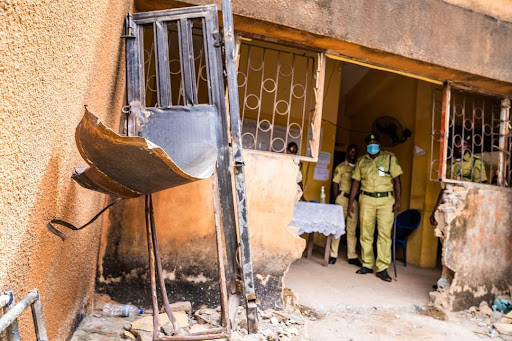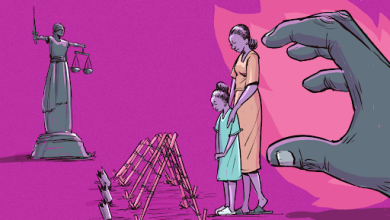The Number Of Jailbreaks In Nigeria Is Rising
The number of correctional facility breaks appear to have soared over the past few years. Why is this the case?

Around 9:30 p.m. WAT on Friday, Oct. 22, heavily armed men invaded the Abolongo Correctional Centre in Oyo, Oyo State. Armed with dynamites, they overpowered officials on duty, before gaining entrance to release hundreds of inmates.
According to a statement by the Nigeria Correctional Service, Oyo State Command, 837 inmates, who were still awaiting trial, escaped from the facility during the attack.
“A total of 262 of the escapees have been recaptured leaving 575 still at large,” the agency’s Public Relations Officer, Olanrewaju Anjorin, said in the statement.
The attack on Abolongo is the eighth jailbreak in the country since October last year. When compared with the four jailbreaks recorded between June 2016 and 2019, it represents a massive increase and raises questions about the security architecture in correctional facilities in the country.
Timeline of jailbreaks: 2016-2019
Muslim inmates at Kuje prison, Abuja, were breaking their Ramadan fast on June 24, 2016, but Maxwell Ajukwu and Solomon Amodu, two high profile kidnappers who were also inmates, had other plans. With the use of a plank, the two criminals scaled the high wall of the prison and escaped. Few days later, senior officials at the prison were queried for their suspected role in the jailbreak.
Less than a week after, on July 29 2016, at least 13 inmates escaped from the Koton/Karfe Minimum Security Prisons in Kogi State, in a pattern similar to that of Kuje amid allegations that they also had support from prison officials.
Roughly two weeks later, the tale of such breaks, thanks to walls that can be scaled, continued when 15 inmates escaped from Nsukka Prison in Enugu State on Aug. 9, 2016.
On June 3, 2018, in what represented the most violent jailbreak in a while, 180 inmates escaped when armed criminals attacked the Minna Medium Security Prison located at Tunga area of Minna Metropolis. The attackers gained access after overpowering prison officials after a gunfire exchange.
Significant spike
In October 2020, in what remains the most vibrant and decentralized campaign by young Nigerians against the unending brutalities and extrajudicial killings of the now-defunct Special Anti-Robbery Squad (SARS) unit of the Nigeria Police Force, streets and major highways across the country were taken over by protesters united by a single symbol: #EndSARS. A few days later, on Oct. 11, Muhammed Adamu, Nigeria’s former Inspector-General of Police (IGP) officially ordered the dissolution of the police unit. In reaction, protesters released a comprehensive list of five demands from the Nigerian government.
As the back and forth between the government and protesters continued, on Oct. 19, suspected hoodlums attacked two Nigerian Prisons in Oko and Benin, both in Edo State. The attack on the two facilities was carried out by hoodlums numbering about 100, leading to the escape of about 1,993 inmates in legal custody who are “convicted criminals serving terms for various criminal offences, awaiting execution or standing trial for violent crimes.”
Reacting to the events, the Ministry of Interior condemned the attack and claimed that security around custodial centres nationwide has been beefed up. This was, however, not enough to prevent another jailbreak at Nigeria Correctional Service facility in Okitipupa, Ondo State. The attack was again carried out by hoodlums who had hijacked the EndSARS protest in the state, leading to the escape of 58 inmates. On the day the incident occurred, the hoodlums had earlier razed about eight police divisions in different parts of the state with several policemen sustaining various degrees of injuries.
However, a jailbreak attempt at the Ikoyi Correctional Centre on the same day was foiled. The attack, which was orchestrated by revolting inmates, was contained by a combined team of correctional officers and soldiers.
On April 5 this year, the trend of jailbreaks in the country returned; this time in Owerri, the capital of Imo State. During the operation, which led to the release of at least 2,000 inmates, the attackers had a free rein that lasted about two hours. The gunmen also attacked the nearby office of the State Criminal Investigation Department (SCID) of the state police command, where they also freed suspects.
Later in the day, the Inspector General of Police claimed that the attackers, who came in their numbers with sophisticated weapons such as General Purpose Machine Guns (GPMGs), Sub-Machine Guns (SMGs), AK49 rifles, Rocket Propelled Grenades (RPGs), Improvised Explosive Devices (IEDs), are members of the proscribed Indigenous People of Biafra (IPOB)/Eastern Security Network (ESN). This allegation was however denied by IPOB members.
Four days after, another jailbreak was foiled at the Nigerian Correction Service, Bauchi state. The trigger event for this jailbreak was a protest by aggrieved inmates over the trial of an NCS officer found to be smuggling ‘prohibited’ substances to inmates. While the protest was ongoing, some inmates from the ‘southern part of the country,’ who were aware of the happenings in Imo State, reportedly teamed up to replicate the same in Bauchi under the guise of protest.
Barely six days later, it took the intervention of officials of the Nigerian Army, 4th Brigade, and the Edo Command, Nigerian Police Force, before another jailbreak could be foiled at a correction centre in Ubiaja, Edo State. This occurred when some inmates, having heard of what happened at Oko, Benin and Owerri, instigated others to riot and effect a possible escape. The attack led to the damage of cells, the administration blocks and medical office in the facility.
Why the surge in jailbreaks?
According to official records of the Nigerian Correctional Service, the current population of inmates across correctional facilities in the country is 70,237. This figure is way higher than the 57,278 inmates carrying capacity of correctional facilities in the country, as revealed by the Interior Minister, Rauf Aregbeshola earlier in the year. To solve this congestion problem, in February 2018, former Interior Minister, Abdulrahman Dambazzau, said the federal government would construct six ultra-modern prisons in the six geo-political zones of the country. But this approach might be reading the problem differently.
Nigerian prisons have a congestion problem; no doubt. But data reviewed by HumAngle suggests that the primary solution might not be the construction of new facilities: according to data from the World Prison Brief, 73.5 percent of inmates in Nigerian prisons are awaiting trial. This indicates that the congestion of prisons in Nigeria is an after-effect of the country’s slow judicial system.
Solomon Emiola, activist and Coordinator of the Take It Back Movement in Oyo State who has been in constant touch with prison inmates, says the surge in attacks on prisons in the country was caused by a number of factors prominent among which is the congested prison and slow judicial process.
“There are things that call for concern. The prison itself is congested. How would you have a thousand plus in a prison while over five to five hundred are still awaiting trial,” he asked this reporter rhetorically.
Emiola, who has spent a good part of the last 12 months visiting Nigerians detained during the EndSARS protest last year but still awaiting justice in the Oyo State, noted that the lack of independence in the judiciary plays a pivotal role in the congestion in the correctional facilities.
“In Oyo State, a prison was attacked twice within four days. This shows that the prison itself is not strengthened in terms of military personnel and anything they want to do psychologically, morally, all these things need to be put in place. When you have a notorious criminal in prison alongside people who are innocent, that is dicey. It’s either the notorious criminal influenced or reoriented the innocent person to become a gang criminal and this has contributed to the problem of the society.”
Way forward
Before now, criminal proceedings in Nigeria were totally regulated by the Criminal Procedure Act (CPA) and the Criminal Procedure Code (CPC). While the CPA mandates that the Police Force “arraigns persons in its custody within 24 hours of their arrest before a magistrate’s court that has jurisdiction to determine the charges against the accused persons” the CPC emphasises that the NPF shall not detain a person in its custody for more than 24 hours. However, on the application of the NPF a court may authorise the detention of a person for a period that is not to exceed 15 days.”
However, despite the provisions of these acts, police officers easily detain people for a longer period using a tactic widely regarded as “holding charge”. The tactics entails arraigning “a person suspected of having committed an offence before a magistrate’s court under a ‘phony or miniature charge” in order for the court to remand the accused person in prison pending the conclusion of their investigation into the matter. After the conclusion of the investigation, the individual is formally arraigned under a proper charge before a court of competent jurisdiction and with the fake charge is withdrawn”.
In 2015, the Administration of Criminal Justice Act (ACJA 2015) was introduced by the federal government to close the judicial loopholes in criminal proceedings, ensure the speedy dispensation of justice and the efficient management of criminal justice institutions. So far, 30 states including the Federal capital territory have domesticated the ACJA.
According to Sylvester Uhaa, the Executive Director of Citizens United for the Rehabilitation of Errants (CURE-Nigeria), a proper implementation of the ACJA is essential to the decongestion of correctional facilities in the country. For example, according to section 293 of the Act, an accused person must either be granted bail or charged to court within a maximum of 72 hours after arrest. “The arbitrary and excessive use of pre-trial detention in Nigeria, besides being a driving factor for increasing prison rates, is a massive form of human rights abuse.”
Meanwhile, Timothy Avele, the Managing Director of Agent-X Security Ltd, explained that the way forward is for prison authorities to retrain and equip their Intelligence units for more actionable intelligence and counterintelligence.
“There’s a need for technology-assisted 24/7 facility monitoring and surveillance through advanced CCTV cameras, possibly 4g Solar cameras, systems linked to the Central Monitoring System,” Avele told HumAngle on Wednesday night.
“Thirdly, as many covert investigations have indicated, there’s corruption in the system and this must be tackled and reduced to the barest minimum if it’s not possible to totally eradicate. And finally, officers need to be motivated and encouraged through promotions and prompt benefits payment,” he added.
Support Our Journalism
There are millions of ordinary people affected by conflict in Africa whose stories are missing in the mainstream media. HumAngle is determined to tell those challenging and under-reported stories, hoping that the people impacted by these conflicts will find the safety and security they deserve.
To ensure that we continue to provide public service coverage, we have a small favour to ask you. We want you to be part of our journalistic endeavour by contributing a token to us.
Your donation will further promote a robust, free, and independent media.
Donate HereStay Closer To The Stories That Matter




